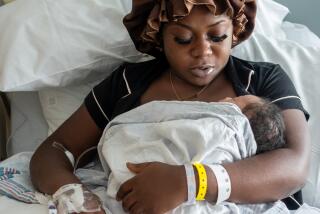35% of Dutch Mothers Give Birth to a Trend: Delivering Babies at Home : Health care: They contend the psychological benefits far outweigh any medical risk.
- Share via
AMSTERDAM, Netherlands — Holland leads the industrial world in home birth, providing a system of midwifery and nursing that offers women the comfort of having babies in their own bedrooms.
More than one-third of Dutch mothers give birth at home--about 60,000 a year--compared to 5% or fewer in other industrialized countries, according to the World Health Organization.
That reflects the strong commitment to women’s rights in this social-welfare state of 14.6 million people and has created a cross-border argument between the Dutch, supported by WHO, and the German medical Establishment.
“Netherlands maternity care is an enormous thorn in the side of obstetricians in all other industrialized countries,” said Marsden G. Wagner, the U. N. health organization’s maternal and child health officer for Europe.
Wagner, based in Copenhagen, accuses the medical profession of trying to keep a monopoly on obstetrics by claiming that home birth is dangerous.
Those who prefer it believe giving birth at home is safer than in a hospital, and that the psychological advantages far outweigh any medical risk.
Government statistics say the rate of infant death at home is 2 per 1,000 births, compared to 9 per 1,000 for all births.
At 5 a.m. one day, Dini Schuitemaker, an Amsterdam teacher, telephoned her midwife to say the baby was coming.
Astrid Limburg arrived at 5:30 and baby Anna’s first cries came at 6:20, with father Ton and the other two Schuitemaker children looking on.
“When a baby comes, it is not an illness; it’s not necessary to go to the hospital,” said Dini, 34, whose other children also were delivered by Limburg. In Limburg’s view, “People function better in their own surroundings. If somebody is healthy and had a healthy pregnancy, to give birth at home is safer than to give birth in the hospital.”
The 1,000 licensed midwives in Holland, who received three years of obstetrics training, are the key to the system.
A midwife sees a woman about 12 times during her pregnancy, to monitor both mother and baby. “We give them self-confidence and we put the responsibility in their own hands,” Limburg said.
Midwives also watch for complications that might necessitate a hospital delivery. In those cases, such as twins or anticipated breach or Cesarean deliveries, the woman is referred to a specialist for prenatal care and hospital delivery.
After the delivery, a maternity assistant provides home care for mother and baby. The costs of both midwife and maternity assistant are paid by the national health insurance system.
In the Netherlands, midwifery has been a respected profession since the 1860s, when the first training school opened. Home births declined over the next century, but have stayed at about 35% since 1978.
One ardent supporter is Holland’s pre-eminent obstetric gynecologist, G.J. Kloosterman, author of the standard obstetrics textbook “Human Reproduction.”
After tracking both systems for decades, Kloosterman believes the home is a better psychological environment for birth than a hospital.
Even for births without prenatal complications, he said, obstetricians often use forceps, suction or Cesarean sections. Midwives are not authorized to use those procedures.
Kloosterman, 76, believes that physicians tend to look for trouble because they have a disease-oriented state of mind.
“They are confronted with pathology all day, and midwives are confronted with healthy mothers,” he said.
Recently, Kloosterman took on the German Obstetrics and Gynecology Society after it sent a letter to the German Health Ministry criticizing home birth.
It said home birth should be banned as dangerous and questioned whether the practice put a mother’s rights above those of her unborn child.
What if something does go wrong during a birth at home?
“We’re the most densely populated country in Europe,” Kloosterman said. “Everyone lives within 20 minutes of the nearest hospital, and that’s enough time.”
More to Read
Sign up for Essential California
The most important California stories and recommendations in your inbox every morning.
You may occasionally receive promotional content from the Los Angeles Times.













